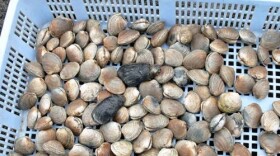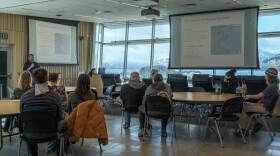Last week the Kodiak Area Native Association issued an advisory about elevated toxin levels in shellfish sampled around the island’s road system. Some were six times above the FDA regulatory limit, which is 80 micrograms per 100 grams.
KANA is not a regulatory agency and the consumption of wild shellfish in Alaska is considered ‘eat at your own risk’.
Toxins at these levels can cause paralytic shellfish poisoning or PSP in people who eat the contaminated shellfish. These same toxins, like saxitoxin, can also negatively impact marine mammals.
KANA’s advisory was based off of samples its environmental team collected from a handful of sites across the road system around Aug. 22.
Andie Wall, the environmental programs supervisor with KANA, said her team took additional shellfish samples last month to send to the lab in Sitka for testing.
“In an effort to be better, more reactive, and try to understand the scope of the bloom, we did all the way from White Sands out to Thumbs Up in Chiniak," Wall said. "And I think we did 10 different locations in addition to our primary sites.”
PSP symptoms include tingling in the lips and fingertips, numbing of the arms and legs, nausea, difficulty breathing and even death. Anyone with these symptoms should seek immediate medical care, or call 9-1-1 or their local clinic immediately.
The toxin levels found in these shellfish point to harmful algal blooms.
Steve Kibler, a scientist with the National Oceanic and Atmospheric Administration, studies these blooms all over the country, including in Alaska. He’s been onboard the research vessel Oscar Dyson for weeks at various times last summer and this summer studying them around Kodiak Island.
Kibler said so far the research team are two years into a four-year study on harmful algal blooms and have found very different patterns.
“One of the things that we immediately noticed is that you can have a really high density bloom out there, but not necessarily any shellfish toxicity, because if there's no shellfish there, then there's nothing to be toxic," he explained. "It's a little bit scary, because the more you learn, the more you realize how variable this is. But also, it doesn’t take much to switch that from no toxicity at all to a really high toxicity event.”
In June of last year, Kibler said two blooms showed up in Kalsin Bay and the other near Spruce Island. But by August he said the blooms had shifted to the northern side of the island near Gibson Cove.
Kibler suspects the movement of these blooms has to do with the water circulation and wind patterns around Kodiak during those times. But it will take more time and more data from future studies to be able to predict where these blooms occur.
In the meantime, all local shellfish harvesters can submit samples to KANA for free harvest-and-hold testing. Contact KANA’s Environmental Team at environmental@kodiakhealthcare.org or (907) 486-1313.
Editor's note: This article has been updated to reflect Andie Wall's current job title.






